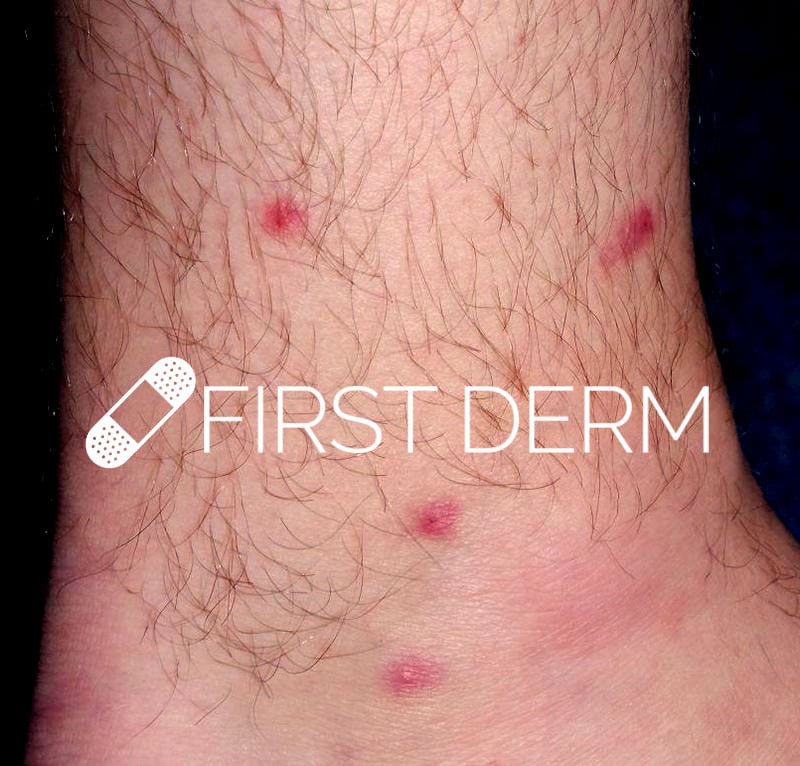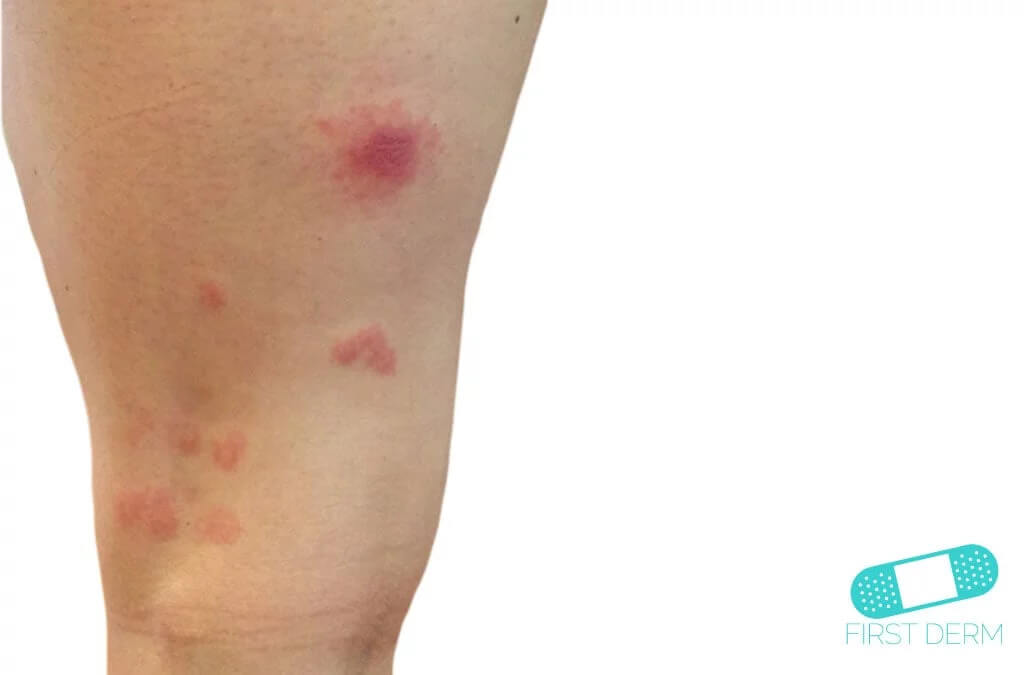Itchy Red Bumps on Skin – Potential Causes
We’ve all had it happen: You feel a surprise itch, and when you reach down to scratch your skin feels rough and bumpy. You look in the mirror and see a red, irritated patch. Although they can be incredibly annoying, red, itchy, bumpy rashes are very common. But what causes your skin to break out like that?
There are potentially hundreds of conditions that can cause your skin to flare up in protest. Luckily very few of them are serious, although certain skin issues should be checked out by a doctor
Red Bumps – Trace Your Steps
Outbreaks of itchy red skin bumps are very common and have many different causes. If you’re experiencing outbreaks, there are a couple of things you should consider before talking to a doctor. Having these things in mind will help the doctor make a more accurate diagnosis.
Is this what you have? Try our FREE Skin Image Search today and get peace of mind

Itchy Red Bumps – What is the cause?
Recent Contact?
First of all, you should think about anything unusual you’ve come into contact with recently. This list can include both natural materials (such as fruits or leaves) and artificial ones (like household chemicals). Then you should check to see if anything on that list stands out to you: maybe you ate a fruit that you don’t normally eat, or used a new soap that you just bought. If something jumps out, it’s likely that you have allergy related hives.
A remote doctor can confirm a case of allergy related hives in just a few minutes . After getting your case diagnosed, you should ask your primary doctor about getting a blood allergy test. The blood allergy test can look at your sensitivity to hundreds of different allergens and give you a full picture of your allergies. You can use that information to avoid outbreaks in the future.
Disease of Infection?
If your rash doesn’t seem related to an outside source, the next most likely cause is a disease or infection. Infection related rashes are easy to spot because they normally come with other symptoms. They also usually appear after contact with an infected person.
There are dozens of different types of infections that can cause itchy red bumps to appear on the skin, including chickenpox and impetigo. Skin diseases caused by parasites, such as scabies, also fall into this category. Before talking to a doctor, take a few minutes to list out your other symptoms (if you have any). Giving the doctor this information makes it much easier for them to narrow down the possible causes, which means a faster and more accurate diagnosis.
Noticed something similar? Try our FREE Skin Image Search today and get peace of mind
Outbreak – Time period?
Finally, think about how long your outbreak lasts. This information is important because different causes create rashes and red bumps with different durations. Allergy related hives, for example, rarely last more than a day (as long as the allergen is removed). Outbreaks caused by infections, on the other hand, typically last much longer. Doctors can use information about the length of your outbreak to confirm their diagnosis.
Itchy red bumps are annoying and uncomfortable, but they’re typically not difficult to diagnose and treat when doctors have the right information. If you’re struggling with an outbreak of itchy red bumps, take a few minutes to consider the questions above and have a remote doctor take a quick look. Their expertise might save you a lot of discomfort!
Is this what you have? Try our FREE Skin Image Search today and get peace of mind
Itchy Red Bumps – Most Common Causes
OK, so you’ve gone through our questions and now you’re left wondering what those itchy red bumps are exactly… First you could try our Artificial Intelligence, this will anonymously provide an answer just from an image of your skin. Its 80% accurate, so if you would prefer the eyes of a dermatologist then of course, we have a solution for that too!
Acne
Sometimes called pimples or zits, happens when dirt, oil, sweat, and dead skin cells block pores. The blockage can become compressed and hard, forming blackheads or whiteheads. Bacteria trapped in the pore cause a small infection, filling the pore with pus and making the surrounding skin red, swollen and painful.
![Acne Vulgaris (19) chin [ICD-10 L70.0]](https://firstderm.com/wp-content/uploads/Acne-Vulgaris-Acne-19-chin-ICD-10-L70.0.jpg)
An example of Acne on the Face
Acne is the most common skin condition and happens most often during adolescence, when surging hormones stimulate the production of oil and sweat. It usually occurs on the face, but can be found on the neck, chest, back, groin, or shoulders. It’s not a serious condition, but heavy acne can be embarrassing and scratching can cause scarring.
There are many over-the-counter medications for treating acne containing benzoyl peroxide or salicylic acid like CeraVe Salicylic Acid Acne Treatment. These ingredients can help remove bacteria and stop pores from becoming clogged. However, if those medications are ineffective, a dermatologist can provide stronger treatments to heal existing acne and prevent future breakouts.
Eczema
This is a skin condition that causes patches of dry, red skin that are very itchy. In some people eczema patches look rough or scaly. It’s common in babies and young children, especially on the cheeks or in folds of the skin such as behind the knees. Most children outgrow eczema, but sometimes it first appears or sticks around into adulthood. Eczema needs to be diagnosed by a doctor but can usually be treated at home.

Example of Eczema on the Neck
For most people, eczema is exacerbated by triggers, or things in the environment that cause the skin to react. Dry air or skin is often a trigger; keeping the skin well-moisturized and using a humidifier can help a great deal. For other people irritants or mild allergies can cause eczema rashes to appear. Eczema can even be set off by stress or hormones.
Treatment involves avoiding triggers and irritating chemicals or clothing, taking lukewarm showers, and keeping the skin well-hydrated. If symptoms persist, a dermatologist can prescribe a steroid cream or even phototherapy, which uses UV light to reduce the itch.
Insect bites
Especially mosquito bites, are a common cause of itchiness and bumpy skin. Other bugs that bite or sting include bees and wasps, spiders, ants, bedbugs, mites, ticks and fleas. Bites may be painful, like a bee sting, or barely noticeable until the area develops an itchy red lump. They may show up as numerous tiny bumps or one larger bite.

Example of an Insect Bite on the Leg
The best way of handling bug bites is prevention: When outdoors use bug repellant and wear long sleeves, long pants, and sturdy shoes. At home only open windows or doors that can be covered with screens, and make sure pets have been treated with flea and tick medication.
Most bites or stings can be treated with first aid. Cool compresses or ice will relieve pain and itching, and pain medications or over-the-counter creams containing hydrocortisone can provide relief. It is important to be aware, however, that certain insect bites can be dangerous or spread disease. Some people are also allergic to insect venom, especially bee stings, and this can cause a medical emergency.
If you or someone with you has been bitten and you notice symptoms such as severe pain, swelling in the lips or face, rapid heartbeat, or trouble breathing, get to a doctor right away. In addition, you should schedule an appointment with your doctor if you experience symptoms such as a rash, aching joints, or fever in the days and weeks after a bug bite.
Psoriasis
This skin disease affects 2-3% of the population, causing patches of red, scaly, flaking skin that may itch. Sometimes the patch is raised and rough or bumpy. It can look silvery, and sometimes it can look like tiny red dots or blisters. These rashes can appear anywhere on the body, but are most often found on the elbows, knees, and scalp. Some patients also experience aching, swollen joints. In psoriasis, something triggers the immune system to overreact, and the top layer of skin begins to grow too fast. This causes the flakey, itchy patches.

An Example of Psoriasis on the Leg
Mild psoriasis can usually be treated with special creams or shampoos that reduce symptoms and relieve itching. In more severe cases, a dermatologist will prescribe stronger medications, including prescription creams, oral medications that are taken by mouth, or light therapy. There is no cure for psoriasis. It can be irritating and sometimes embarrassing, but it is not contagious and can usually be managed well. Seeing your doctor is important to stay healthy and reduce your symptoms.
Folliculitis
This commonly occurs when hair follicles become blocked or damaged, leading to infection and irritation that may become itchy or swollen and painful. It is common in the groin and pubic area, but may also occur in other places on the body, especially the face where shaving can introduce bacteria into the skin.
![Folliculitis (Barber’s Itch) (02) right leg [ICD-10 L73.9]](https://firstderm.com/wp-content/uploads/Folliculitis-Barber’s-Itch-02-skin-ICD-10-L73.9.jpg)
An example of Folliculitis
It may look like a rash of tiny red or white bumps; infections deeper in the skin may look like large, red, inflamed lumps that weep fluid. The sores can be slow to heal or might keep coming back. Folliculitis is usually an infection caused by bacteria, but it can also be caused by fungus (such as yeast), viruses, or ingrown hairs.
Folliculitis is caused by friction, shaving, or certain skin conditions that make you more susceptible to infection. It is not caused by poor hygiene. However, once you have developed folliculitis, keeping the area clean and dry can help speed healing. Hot compresses can relieve some of the pain and itching, and antibacterial creams can also help. If home remedies are not effective, a dermatologist can drain large incisions and prescribe medications to treat the infection and reduce inflammation.
Scabies
This an extremely itchy rash made up of many tiny, red sores or bumps, sometimes occurring in lines across the skin. The itching is intense and usually more noticeable at night. Scabies rashes can appear anywhere on the body, but are most common on the hands and arms or in areas closely covered by jewellery or clothing, such as the belt line.
![Scabies (01) arm [ICD-10 B86]](https://firstderm.com/wp-content/uploads/Scabies-01-arm-ICD-10-B86.jpg)
An example of Scabies on the Arm
In some cases a rough, scaly patch can form over the rash. Scabies is caused by an infestation of skin mites, tiny bugs that are so small they are invisible to the naked eye. They burrow into the skin in trails, and proteins from their bodies or waste cause a significant, itchy reaction in the surrounding skin. It takes several days after becoming infected with mites for the rash to appear.
Scabies is extremely contagious, and anyone who is in close contact with an infected person can catch scabies. It can be transmitted through skin-to-skin contact, or by sharing items such as towels, clothes and bedding. People who live together in groups, such as those in nursing homes or dorms, are at higher risk of getting scabies.
Speak to a Dermatologist Immediately
If you think you have scabies, you should see a dermatologist right away. This is a common infection and not something you need to be embarrassed about. Doctors see scabies all the time and have medications that can treat it. The most widely used treatment is a cream that is applied over the entire body at night and washed off in the morning.
Everyone who has been in contact with the diagnosed person should also be treated. Towels, clothes, and bedding should all be washed in hot water and carpets should be vacuumed well. Even though the medicine works right away, it can take up to four weeks for the rash to completely go away and the skin to heal.
Actinic keratosis
This one or more small patches of rough, grainy, or raised skin caused by damage from the sun. The spots start very small and can grow to an inch or more in diameter. They are usually red, but can also be pink or the same color as surrounding skin. Typically these spots are found on areas of skin that are exposed to the sun, such as the face, arms and hands, or a bald scalp. Older people are at higher risk of developing actinic keratosis simply because they have accumulated more hours of sun exposure during their life.
![Actinic Keratosis (AK) (05) hand [ICD-10 L57.0]](https://firstderm.com/wp-content/uploads/2016/11/actinic-keratosis-11.jpg)
An example of Actinic Keratosis on the Hand
Actinic keratosis should always be seen by a dermatologist, because if it is left untreated the sores have the potential to turn into skin cancer. If it is caught early, the spots can be safely and easily removed before they become problematic. The damaged areas can be removed by freezing, cutting them away, laser therapy, light therapy, or strong medicated creams. Your dermatologist will examine the sores and decide which method is best for you.
Itchy Red Bumps – Get Checked!
These are just a few of the most common conditions that can cause your skin to become irritated, resulting in an itchy, red, or bumpy rash. Most of the conditions that cause itching and redness are not serious. But skin problems can be quite uncomfortable, and it can be difficult to figure out what has caused the rash just by looking at it. Seeing a dermatologist to get a proper diagnosis and treatment will make you much more comfortable, and in some cases it can stop you from getting very sick.

The Specialist doctor from the University Hospital in Gothenburg, alumnus UC Berkeley. My doctoral dissertation is about Digital Health and I have published 5 scientific articles in teledermatology and artificial intelligence and others.



